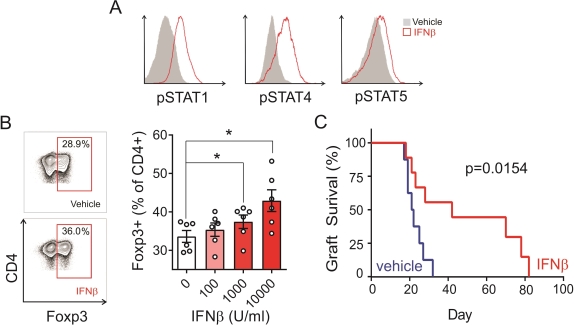Interferon-b Promotes Regulatory T Cell (Treg) Induction and Prolongs Allograft Survival
1Neurology, Icahn School of Medicine at Mount Sinai, New York
2Medicine, Translational Transplant Research Center, Recanati Miller Transplant Institute, Icahn School of Medicine at Mount Sinai, New York.
Meeting: 2018 American Transplant Congress
Abstract number: 557
Keywords: Graft survival, Interferon (IFN), T cells
Session Information
Session Name: Concurrent Session: New Approaches to Target Regulatory T Cells
Session Type: Concurrent Session
Date: Tuesday, June 5, 2018
Session Time: 4:30pm-6:00pm
 Presentation Time: 4:30pm-4:42pm
Presentation Time: 4:30pm-4:42pm
Location: Room 618/619/620
Background: Interferon-b (IFNb), a type I interferon with antiviral and pro-inflammatory activity, has been used as an immune modulatory treatment of multiple sclerosis (MS). The effect of IFNb on alloimmunity and transplant rejection are unknown.
Methods: We used mathematical modeling to predict signaling effects of IFNb in T cells, and validated the model through experimental testing of type I interferon receptor (IFNAR) expression and phosphorylated STAT activation in IFNb treated murine and human naïve CD4+T cells by flow cytometry. We perfomed Treg induction assays +/- IFNb and measured frequencies and function of induced CD4+CD25+Foxp3+ Treg. We also treated B6 recipients of BALB/c allografts with IFNb, evaluating graft survival and effects on Treg.
Results: As predicted by the computational model, murine and human naïve CD4+ T cells express IFNAR and IFNb activates STAT1,4 and 5 (Fig. 1A). IFNb augmented TGFb-induced Treg generation in vitro (Fig. 1B) and in vivo following adoptive transfer of allogeneic splenocytes (vehicle vs. IFNb: 6.8 ± 1.4 and 8.8 ± 2.0 %, respectively; p<0.05). IFNb treatment prolonged survival of BALB/c hearts transplanted into CTLA-4 Ig-treated B6 recipients (Fig. 1C).
Discussion: Our translational findings identify a previously unrecognized direct effect of IFNb on human and mouse Treg induction that has the potential to be used to improve allograft survival in humans.
Fig 1. (A) Flow histograms depicting STAT1, STAT4 and STAT5 phosphorylation in human naïve CD4+ T cells 30 min after vehicle (solid, grey) or 10,000 U/ml of IFNb (red) (representative of 4 different experiments). (B) Percentage of CD4+Foxp3+ Treg at day 5 after Treg induction +/- IFNb (representative plots, left, and data quantification, right, of 6 mice). (C) Kaplan-Meier curves of heart allograft survival in mice treated with vehicle or IFNb (10,000 U daily for 5 days and then weekly) * p<0.05.
CITATION INFORMATION: Fribourg M., McGinty M., Angeletti A., Demir M., Sealfon S., Heeger P., Cravedi P. Interferon-b Promotes Regulatory T Cell (Treg) Induction and Prolongs Allograft Survival Am J Transplant. 2017;17 (suppl 3).
To cite this abstract in AMA style:
Fribourg M, McGinty M, Angeletti A, Demir M, Sealfon S, Heeger P, Cravedi P. Interferon-b Promotes Regulatory T Cell (Treg) Induction and Prolongs Allograft Survival [abstract]. https://atcmeetingabstracts.com/abstract/interferon-b-promotes-regulatory-t-cell-treg-induction-and-prolongs-allograft-survival/. Accessed December 18, 2025.« Back to 2018 American Transplant Congress

